Topkapi Palace Artifacts, Entrance Fee & Hours
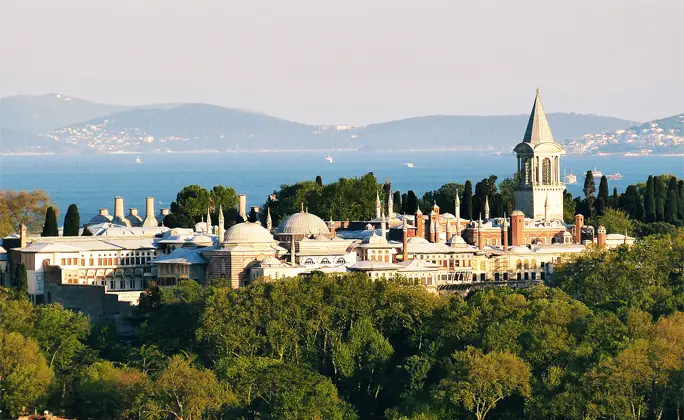
Topkapı Palace is a building that has hosted many civilizations throughout the history of Asia Minor and Istanbul and stands out with its religious and cultural riches.
The palace, which is one of the concrete examples of this wealth, is a structure that sheds light on the Ottoman Empire period and attracts millions of tourists every year with its magnificent works and architecture.
We will discuss in detail the history of Topkapi Palace, an iconic structure like the Galata Tower and the Maiden’s Tower, who built it, what kind of works it contains, and the opportunities it offers to visitors.
You can also take a look at our article on minimalist travel accessories to travel around Istanbul comfortably.
Brief History of Topkapi Palace
Topkapı Palace is a historical place that represents the rise of the Ottoman Empire, where the sultans and the ruling elite lived for centuries and where state affairs were carried out.
The palace, which started to be built about 6 years after the conquest of Istanbul, has been the administrative center of the Ottoman Empire for about 400 years. It was opened to visitors as a museum in 1924.
During the period until the construction of Dolmabahçe Palace, 25 Ottoman sultans stayed in this palace. The architecture of the palace has been expanded and enriched by different sultans and architects over the years, so the palace has many different architectural features and styles.
Topkapı Palace has an important place among the Istanbul Museums today.
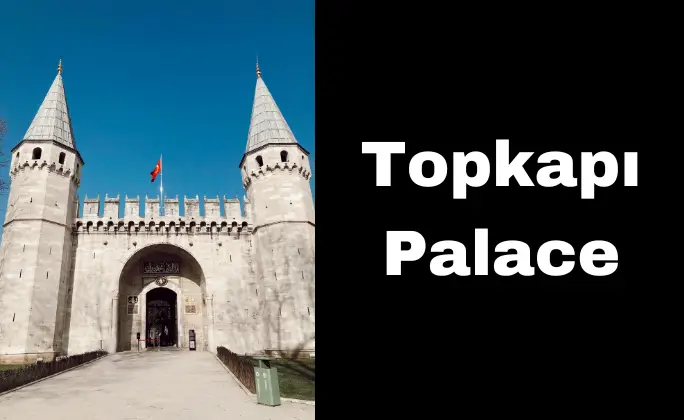
Who Built Topkapi Palace
The construction of Topkapi Palace was started by Fatih Sultan Mehmet (Mehmet the Conqueror) in 1459, after the conquest of Istanbul by the Ottomans.
Fatih Sultan Mehmet was a leader who conquered Istanbul by ending the Byzantine Empire, which was considered the continuation of the Roman Empire and brought the Ottoman Empire to its peak. After this success, he ordered the construction of this palace, which would be the new administrative center of Istanbul.
The first construction stages of the palace were entrusted to Alaüddin, who was the chief architect of the Ottoman Empire at that time. The palace, which has expanded and enriched over the years with the contribution of many architects and artists, reflects the magnificence and cultural richness of the Ottoman Empire.
Architecture of Topkapi Palace
Topkapi Palace is one of the most beautiful examples of Ottoman architecture and Islamic art. The palace complex consists of four main courtyards and, in addition, many subsidiary structures. Behind the first courtyard, there is the second courtyard, followed by important buildings such as the harem, the Revan mansion, the private room, and the Bagdad mansion.
In the palace, where stone and wooden materials are generally used together in architecture, door decorations, tiles, and domes attract attention. Walls covered with Iznik tiles, gilded ceilings, and elegant decorations reflect the magnificence and wealth of the Ottoman Empire.
The Harem section is particularly striking and was used as the private living space of the Ottoman sultans and their families. The numerous rooms in the harem are known for their remarkable stonework and colorful tiles.
In addition, the Enderun Library and other libraries in the palace host very important works in terms of book art and bookbinding.
The gardens and courtyards of the palace also have a special feature; Various plant species as well as rare animal species have been hosted here from time to time. Just like in the Ottoman period, today these gardens offer a peaceful atmosphere to visitors.
In short, the architecture of Topkapı Palace is a complex that best reflects the cultural, artistic, and historical richness of the Ottoman Empire. This unique structure, each corner of which carries a different story and aesthetic value, is an important part of not only Turkey’s but also the world’s cultural heritage.
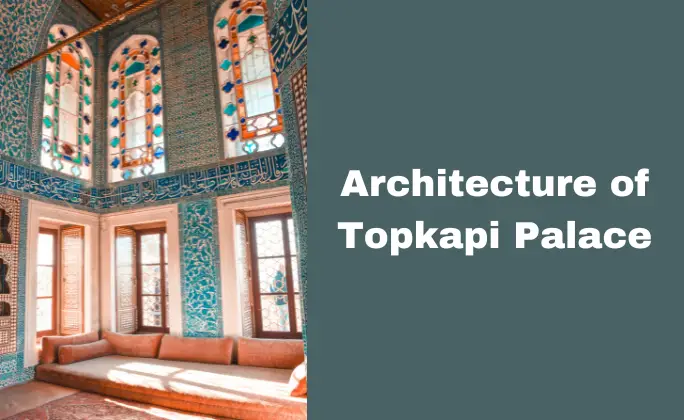
Topkapi Palace Sections and Artifacts
In this section, let’s take a look at the Topkapi Palace Sections and important Artifacts.
First Courtyard (Alay Square)
The First Courtyard is the outer courtyard of Topkapi Palace and is commonly known as the Alay Square. During the Ottoman period, this was a place where official ceremonies, processions, and the public gathered. The design, openness, and size of the square represent the splendor of the Ottoman Empire.
The works found in the first courtyard are as follows;
Hagia Irene Church
The most important building in this courtyard is the Hagia Irene Church. Dating to the Byzantine period, this building was used as a weapons depot after the Ottoman conquest of Istanbul. Today, it serves as a venue for various cultural events and exhibitions.
Imperial Gate (Bâb-ı Hümâyûn)
The entrance to the palace complex is through a magnificent gate called the Imperial Gate. This gate was designed as a gate that only the sultan could pass while riding a horse. The towers on both sides of the gate and the gilded Ottoman crests on it make visitors feel the magnificence and power of the Ottoman Empire at the first step.
This courtyard usually has a simple and functional architecture, but this simplicity represents the military and political power of the Ottoman Empire. From here, another gate is passed to reach the second courtyard (Divan Square); This gate is called Divan Gate or Middle Gate. Access to the second courtyard was allowed only to the sultan and high-ranking officials during the Ottoman period, which once again reveals the importance of this courtyard.
This first courtyard draws attention as an area that brings together the military, political, and cultural aspects of the Ottoman Empire. Visitors get their first impression of the rich history of the Ottoman Empire and Istanbul in this courtyard.
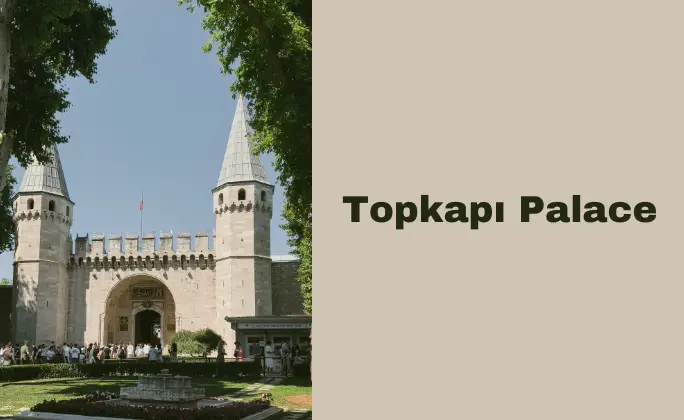
Second Courtyard (Divan Square)
The Second Courtyard functioned as the center of the legislative and executive mechanisms of the Ottoman Empire. This courtyard is surrounded by various buildings critical to the administration of the empire.
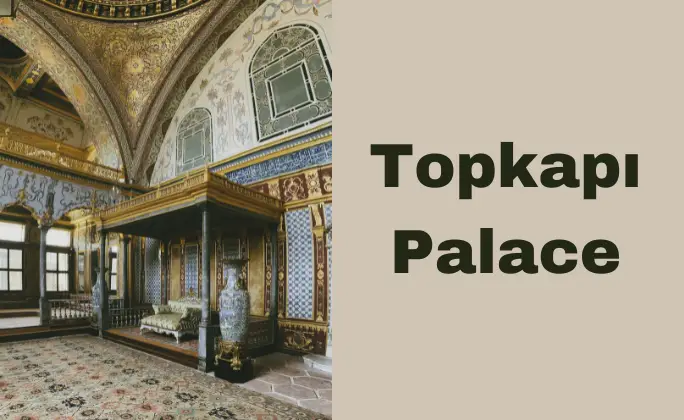
Divan-ı Hümayun (Palace Council)
Divan-ı Hümayun is the most important structure of the Second Courtyard and is the place where the judicial and administrative affairs of the Ottoman Empire were carried out. The sultan’s advisors, high-ranking officials, and legal representatives of the state would gather here, create laws, and make judicial decisions. The interior decoration of the building reflects the architectural and artistic riches of the period. The reliefs adorning the walls are decorated with geometric and floral motifs specific to the period.
Kitchens
The Cuisines section is another important section where the Ottoman cuisine and therefore its cultural richness are revealed. In this section, where meals are prepared, various kitchen utensils, containers, and porcelain specially designed for the sultan and his courtiers are also exhibited. Spices, meat, and vegetables brought from all over the Ottoman Empire were turned into art in the hands of masters here.
The courtyard does not only host these two structures; At the same time, buildings, where various treasures, weapons, and holy relics are stored, are also located in this courtyard. In addition to being the administrative center of the Ottoman Empire, the Second Courtyard offers many clues about the social and cultural life of the empire. Both the decisions taken at the Imperial Council and the meals prepared in the Kitchens aim to preserve the power and magnificence of the Ottoman Empire.
With all these structures and their functions, the Second Courtyard offers valuable information to visitors about the complex and multifaceted history of the Ottoman Empire.
Sultanate Cars Section
The Imperial Carriages Section is one of the most interesting sections offered to the visitors of Topkapı Palace. In this section, royal carriages, palanquins, and similar transport vehicles from the Ottoman period are exhibited. These means of transport reveal the richness, magnificence, and artistic creativity of the period.
These chariots and palanquins were often used for special ceremonies, weddings, holidays, and other important state affairs. These vehicles, in which sultans or important people in the palace were transported, have remarkable details, elegant decorations, and valuable materials.
In the Ottoman Empire, the making of the sultanate cars was considered an important branch of art, and master artists were carefully selected to make these cars. These works, which usually combine various materials such as wood, metal, and fabric, were created by the best artists of the period. Each vehicle is a masterpiece, both functionally and aesthetically.
Porcelain, Glass, and Tiles Used in the Ottoman Palace
In Ottoman palace life, porcelain, glass, and tiles were used not only to meet daily needs but also as an aesthetic and artistic expression tool. These products are one of the details that reflect the wealth and splendor of the palace and were often displayed in private ceremonies or state affairs.
If you are interested in these decorations, it is the second place worth seeing in Istanbul after the Hagia Sophia Mosaics.
Chinese and Japanese Porcelains
The Chinese and Japanese Porcelain Department of Topkapı Palace has one of the most comprehensive examples in the world. The Ottoman Empire had very intense commercial and cultural relations, especially with China and Japan. These porcelains were usually produced by special order or received as gifts. Extremely diverse and elegant in terms of motifs, colors, and craftsmanship, these porcelains adorned the dining rooms, reception halls, and private spaces of the palace.
Ottoman Glass and Porcelains (Kitchens, Matbah-I Amire)
Ottoman glass art is very famous, especially with Iznik tiles. The Kitchens, Matbah-I Amire section of Topkapı Palace provides detailed information and examples on this subject. Porcelain and glass products inspired by Ottoman cuisine were used in food presentation and decoration. The richness of color and form of Ottoman glass reflects the sophistication and artistic taste of the inhabitants of the palace.
Iznik Tiles
Iznik tiles, which are the most famous ceramic products of the Ottoman period, also found a wide place in Topkapı Palace. This important example of Turkish art is usually in blue, green, and red and decorated with geometric and floral motifs. Iznik tiles cover the walls, fountains, and even some objects of the palace, and these works of art reflect the Ottoman’s high aesthetic sense and artistic skill.
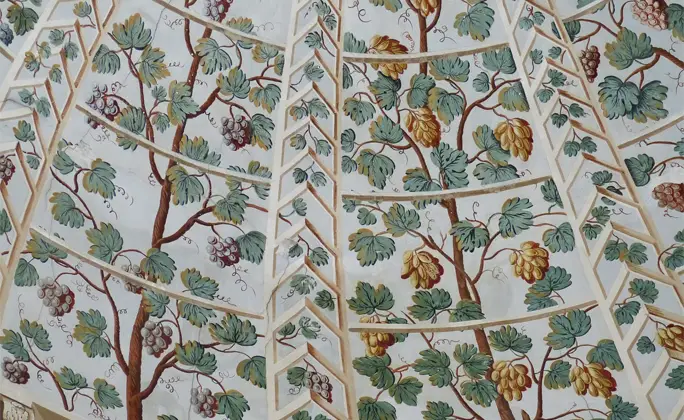
Third Courtyard (Enderun Courtyard)
The Third Courtyard is one of the most hidden and private areas of Topkapı Palace. This courtyard is one of the places where the most valuable assets of the Ottoman Empire are preserved and stored. This courtyard, which is a real feast of history and culture for visitors, reflects the religious, cultural, and intellectual riches of the Ottoman Empire.
Treasury Department
The Treasury Chamber is a room that houses the priceless treasures, jewels, and royal jewels of the Ottoman Empire. Items decorated with precious stones such as topaz, rubies, and diamonds are an indication of the wealth of the palace and Ottoman rulers. The items exhibited here are the products of the Ottoman diplomatic relations and expeditions with different countries throughout history.
Important Artifacts in the Treasury Department
Some important works exhibited in the Treasury Department are:
- Topkapi Dagger: This dagger, thought to have been made in the 15th century and decorated with diamonds, rubies, and emeralds, is one of the most famous works of the Treasury Department.
- Spoonmaker’s Diamond: This jewel, considered the fourth largest cut diamond in the world, is 86 carats.
- Ottoman Thrones: The thrones used by the Ottoman sultans are exhibited with details specific to various periods and art movements.
- Golden Containers and Objects: In the treasury section of the palace, there are various containers, boxes, and ornaments made of gold.
- Ruby and Emerald Jewellery: Jewelry and accessories decorated with rubies, emeralds and other precious stones from the Ottoman period.
- Sacred Relics: In the Treasury Department, as in the Sacred Relics Department, some objects of religious importance are also protected.
- Miniature and Calligraphy Works: Miniatures and calligraphy works made by famous artists of the Ottoman period.
- Ancient Coins: Ancient coins and coins from the Ottoman Empire and before.
- Various Weapons: Weapons decorated with precious stones used by sultans and important statesmen.
The Treasury Department offers valuable works not only on Ottoman history but also on Islamic and world history. The works are exhibited in climate-controlled environments under strict security measures.
Department of Sacred Relics
The Sacred Relics Department houses the most precious assets of the Islamic world. Personal belongings of the Prophet Muhammad, copies of the Quran, and other sacred objects are protected in this section. This apartment is a space where religious belief and respect are felt at the highest level and gives visitors an impressive spirituality.
Which Sacred Relics Are Exhibited in Topkapı Palace?
The Department of Sacred Relics contains extremely important and valuable objects for the Islamic world. Some of the holy relics exhibited in this apartment are:
- Hz. Sword of Muhammad: Swords believed to belong to the Prophet are exhibited in this section.
- Hz. Kaftan of Muhammad: The caftans believed to be worn by the Prophet Muhammad are also preserved in the Department of Sacred Relics.
- Beard-ı Şerif: The beard hairs of our Prophet are carefully stored and exhibited.
- Hz. Domes of Muhammad: Dome fragments thought to belong to the house of the Prophet Muhammad.
- Copies of the Holy Quran: Hz. Very old copies of the Holy Quran, considered to belong to the Ottoman period.
- Hz. The Staff of Moses: According to the Islamic belief, Hz. Staff thought it belonged to Moses.
- Hz. Yusuf’s Shirt: The shirt is believed to belong to Prophet Joseph.
- Hz. The Stone Used by Abraham When He Was Thrown into the Fire: According to Islamic belief, Hz. Stone thought to belong to Abraham.
These holy relics are an indicator not only of the Islamic faith but also of the religious aspect of the Ottoman Empire. The relics are stored in special boxes and glass bowls under high-security measures. These are objects that Muslims have preserved and treated very meticulously throughout history, and each of them has great historical and religious importance in its own right.
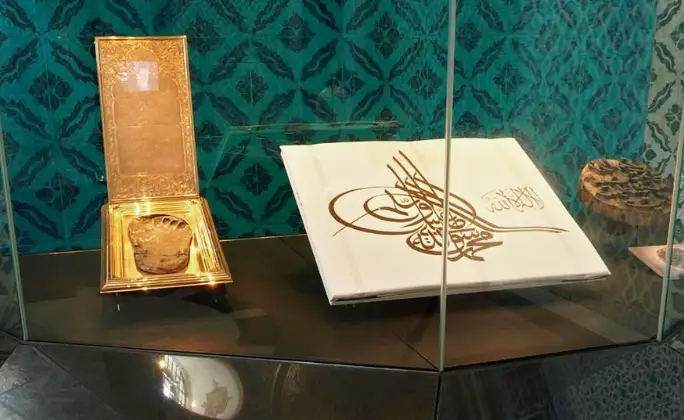
Enderun Library
Enderun Library is another important building that reveals the Ottoman Empire’s contributions to science, art, and culture. Here you can find rare manuscripts and books written by the most important scientists, writers, and artists of the period. The library also hosts works in various languages and subjects.
This courtyard hosts not only the three main sections mentioned above, but also the private rooms of the sultans, mosques where religious ceremonies are held, and areas where other cultural events are held. The Third Courtyard reflects not only the administrative and religious aspects of the Ottoman Empire but also its intellectual and cultural riches.
Fourth Courtyard (Sofa Courtyard)
This courtyard is the innermost and most private courtyard of Topkapi Palace. The courtyard usually contains luxurious and ostentatious buildings such as the Revan Pavilion, Baghdad Pavilion, and Sofa Pavilion. These mansions are usually places where sultans spend their private moments, rest, think, and even carry out state affairs.
Revan Mansion: Built-in 1635 to commemorate the conquest of Revan, this mansion attracts attention with its rich tile coverings.
Baghdad Mansion: IV. in memory of the conquest of Baghdad in 1638. It was built by Murat. It contains valuable miniatures and manuscripts from the period.
Sofa Pavilion: It is a place used by Ottoman sultans for meditation and thought. It has a simple but impressive architecture.
The Fourth Courtyard constitutes the most private and peaceful corner of the palace. This is a serene refuge away from the hectic and complex life of the palace. The sultans not only rested here but also carried out important state affairs and diplomatic meetings here.
There is also a Circumcision Room in this courtyard. This special place, where the circumcision ceremonies of the children of the Ottoman sultans were performed, was decorated with the best works of art of the period.
Each courtyard has unique artifacts that reflect different aspects, cultural richness, and history of the Ottoman Empire. These structures reveal not only the architectural aspects but also the complexity and richness of Ottoman society and administration. The Fourth Courtyard is a summary of this complexity and richness. Both the elegant structure of the mansions and the general atmosphere of the courtyard reflect the Ottoman aesthetics and philosophy of life.
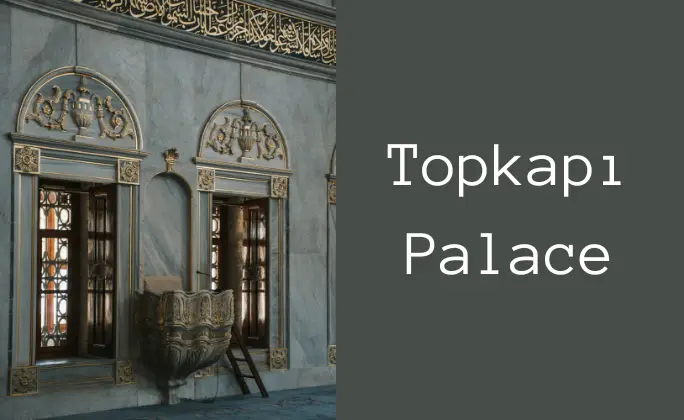
How to Get to Topkapi Palace?
Topkapi Palace is located in the historical peninsula of Istanbul, very close to Sultanahmet square. Therefore, it is very easy to reach the palace. Here are a few ways:
By Public Transport
- Tramway: You can get off at the “Sultanahmet” stop by using the T1 Kabataş-Bağcılar tram line. You can easily find the palace, which is about a 5-10 minute walk from the station.
- Metro: You can take the M2 Yenikapı-Hacıosman metro line to the “Vezneciler” stop and transfer to the tram from there.
If you prefer to go by public transportation, check out our article on Istanbul City Card and Istanbul Metro Map.
By taxi
Taxis are quite common in Istanbul. You can easily reach Topkapi Palace by taxi from almost anywhere, but traffic conditions and taxi fares should be taken into consideration.
You can call a safe taxi here in Istanbul.
By Special Vehicle
For those who want to come by private car, there are usually paid parking lots nearby. However, it would be beneficial to act considering the traffic and parking situation.
Rent a car safely in Istanbul.
On foot
If you are staying in the historical peninsula of Istanbul, you can also walk to Topkapi Palace. It is within walking distance from areas such as Sultanahmet, Eminönü, and Sirkeci.
This central location of the palace makes it easily accessible by different transportation options. Whichever route you choose, you are sure to have a wonderful day visiting this magnificent historical building.
Topkapi Palace Entrance Fee
The entrance fee to Topkapi Palace for tourists for 2023 is 750 TL per person. Additionally, if you want to visit the Hagia Irene and Harem sections, the fee is 950 TL.
If you have a Museum pass Turkey card, you can visit the Hagia Irene and Harem sections free of charge.
Topkapı Palace gets very crowded during the summer months and Turkish religious holidays and the queue for tickets can take a long time. As a solution to this, you can buy a Topkapı Palace fast-track ticket. A private guide service is also offered for people with this ticket.
✅ Buy Fast Track tickets for Topkapi Palace safely.
Topkapi Palace Opening Hours
Topkapı Palace Opening Hours are between 09:00 – 18:00. The palace is closed on Tuesdays. Ticket sales for Topkapı Palace end at 17:30.
It gets very busy at Topkapi Palace during ticket time, so I recommend we leave it until the end of the day.
Topkapi Palace Frequently Asked Questions
Where is Topkapı Palace located?
Topkapi Palace is located in the historical peninsula of Istanbul, close to Sultanahmet Square.
Who built Topkapı Palace?
The construction of Topkapi Palace was started by Fatih Sultan Mehmet in 1459, after the conquest of Istanbul.
How to get to Topkapi Palace?
You can easily reach Topkapı Palace by public transportation, taxi, private vehicle, or on foot. The “Sultanahmet” stop of the T1 tram line is the closest public transportation stop to the palace.
What are the working hours of Topkapi Palace?
Working hours of Topkapı Palace may vary depending on the season. It is usually open between 09:00 – 19:00.
Which sections can be visited in Topkapı Palace?
There are many departments and exhibition areas in Topkapi Palace. Among these, areas such as the Treasury Department, the Sacred Relics Department, the Enderun Library, the Reign Carriages Department, and the Kitchens are important places.
How much is the entrance fee to Topkapi Palace?
Topkapi Palace entrance fee may vary and may be charged according to extra exhibitions. You can visit the official website for updated information.
Which Sacred Relics are exhibited in Topkapı Palace?
Among the Sacred Relics of Islam in Topkapi Palace. Items such as Muhammad’s sword and beard are exhibited.
Can you eat at Topkapi Palace?
There are cafeterias and restaurants within the palace complex, you can eat here.
Can photographs be taken in Topkapı Palace?
Photography is prohibited in some parts, but in general, you can take photos in many parts of the palace.
Is Topkapı Palace disabled-friendly?
Topkapi Palace has made several improvements regarding its suitability for disabled visitors, but it is not exactly a disabled-friendly building. We recommend you visit the official site for detailed information.
How to get to Topkapı Palace from Istanbul Şile?
The easiest way to go from Istanbul Sile to Topkapı Palace by public transport is to first go to Üsküdar and then take the ferry to Karaköy. You can walk or take the tram from Karaköy.
